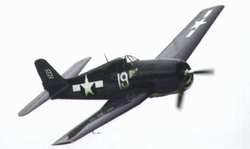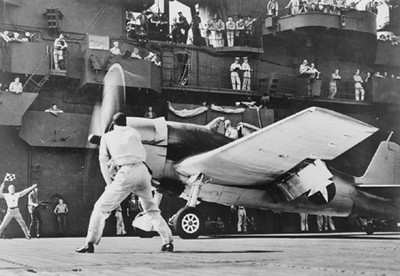Michigan Historic Preservation Office and MSHDA Announce
Recovery Effort
 Weather permitting on Monday, November 30, a World War II,
F6F-3 Hellcat fighter plane will be raised from the depths of Lake
Michigan off the Chicago shoreline. The plane has rested on the
lake bottom for more than sixty years after crashing during a
training exercise.
Weather permitting on Monday, November 30, a World War II,
F6F-3 Hellcat fighter plane will be raised from the depths of Lake
Michigan off the Chicago shoreline. The plane has rested on the
lake bottom for more than sixty years after crashing during a
training exercise.
During the war, navy pilots trained to land on aircraft carriers
in Lake Michigan before seeing active duty. The "aircraft carriers"
used for training were in fact old Great Lakes passenger liners
modified with wooden landing decks. The vessels docked at Chicago's
Navy Pier, and the pilots left from the Glenview Naval Air Station
in Glenview, Illinois. This airplane, an F6F-3 Hellcat Fighter
(serial number 25910), was among many that crashed in the lake
during aircraft carrier qualification training. The airplane was
lost in about 250 feet of water on January 5, 1945. The pilot,
Lieutenant (Junior Grade) Walter B. Elcock, was attempting to land
aboard the USS Sable during training. Lieutenant Elcock survived
the crash and presently lives in Atlanta, Georgia. More than 17,000
pilots completed the training at Glenview, including former
president, and then-Lieutenant (Junior Grade) George H. W.
Bush.
Prior to the activities on Lake Michigan, this particular
Hellcat served with Fighter Squadron VF-38 at Guadalcanal in
1943.
The U.S. Navy is leading the recovery, which is being sponsored
by Enterprise Rent-a-Car and donations by its CEO, Andy Taylor.
Taylor is acting in honor of his father, Jack Taylor, who founded
Enterprise and named it for the most decorated aircraft carrier in
American history, USS Enterprise, CV-6. The National Naval Aviation
Museum, in coordination with the Naval History and Heritage
Command, the Naval Aviation Museum Foundation, and the Michigan
State Historic Preservation Office, will complete the recovery
portion of the effort this week using a crew from A. and T.
Recovery. Following the recovery the plane will be stabilized and
reworked for eventual exhibit.

Before the recovery could occur, much coordination and
consultation took place between the Navy and the Michigan State
Historic Preservation Office (MSHPO), part of the Michigan State
Housing Development Authority. Federal law requires that state
historic preservation offices review and comment on all federally
funded or licensed activities to determine the activity's potential
for impact on historic resources -- above-ground, underground, or
underwater.
"These planes tell the relatively unknown story of the Great
Lakes region's role in training pilots during WWII," stated
Michigan State Historic Preservation Officer Brian Conway. "Our
general preference is to preserve the plane in place on the lake
bottom as part of that story. We recognize, however, that there is
a public benefit to be gained from recovery, stabilization, and
exhibition of this plane. This is the first time an aircraft
connected with carrier training during World War II has been raised
from Michigan waters. We look forward to receiving the information
the recovery will provide."
The entire recovery process and assessment of the plane's
condition will be documented in writing and with video by a
professional archaeologist who will then turn the materials over to
the Archives of Michigan. Consultation with the MSHPO will continue
throughout the rework process and the eventual interpretation of
the plane. Information about the plane's association with the Great
Lakes area and its recovery from Lake Michigan will be made part of
the presentation of the aircraft when it is exhibited.
 Classic Aero-TV: In Praise of Alabamas Patriot Aircraft USA
Classic Aero-TV: In Praise of Alabamas Patriot Aircraft USA NTSB Final Report: Cirrus Design Corp SR22
NTSB Final Report: Cirrus Design Corp SR22 ANN's Daily Aero-Term (12.21.25): Dead Reckoning
ANN's Daily Aero-Term (12.21.25): Dead Reckoning ANN's Daily Aero-Linx (12.21.25)
ANN's Daily Aero-Linx (12.21.25) Aero-News: Quote of the Day (12.21.25)
Aero-News: Quote of the Day (12.21.25)




